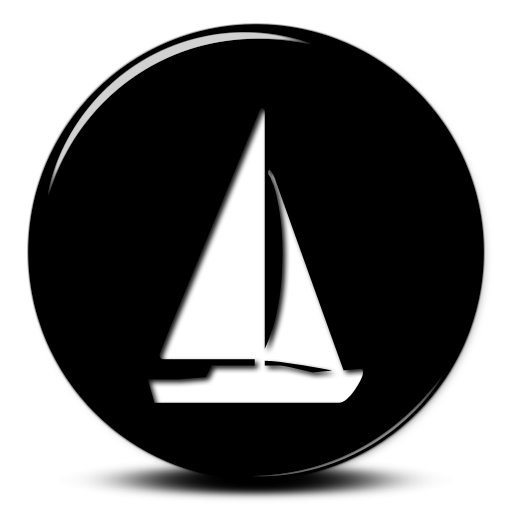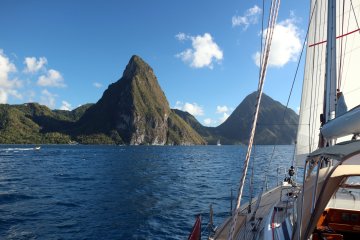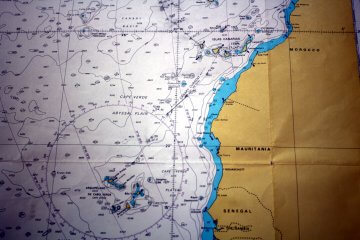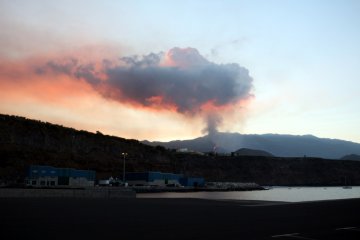Sao Jorge is a never-ending ridge consisting of rugged cliffs and volcanic cones. The highest one, Pico da Esperanca, is 1053m. With just 8600 inhabitants, it is a rather sparsely populated island.
We anchored in front of the small marina of Las Velas for about a week and then asked the impossibly nice harbour master (Jose) for a berth in the marina.
All our batteries had suddenly failed within the same week and we needed to run the generator every 8 hours or so to keep up. We desperately needed a marina berth and new batteries. John researched and found new batteries in Horta, which were could be available by the time we arrived there.
Another problem arose again (for the third time) after our very wet and windy crossing here. Our genoa tracks, or the 39 holes on each side for the bolts that hold them on, were leaking again and salt water had made its way inside. So another item for our “To Do” list…..I sometimes feel that boat life is at least 70% boat repairs and maintenance.
Anyway we did several excellent hikes on the island and also camped there in Faja Grande on a super small campsite with a restaurant and a natural swimming pool. Wonderful!
On our return after the day hike to Faja da Caldeira de Santo Cristo as we walked back to the marina and I noticed something odd about “Maya” and said to John. “Hmm.. ‘Maya’ is in the middle of the harbour entrance…”
Quickly into the dinghy and off to see what’s going on… A rope was tied from “Maya” to our Danish neighbour boat! Our neighbours said that Maya was drifting more and more towards them and they then tied her to their boat to stop her drifting away. What a fright!
We’d actually thought that the anchor was stuck between rocks as we’d been there for 3 days and we had already tried 3 times to get it up. But somehow it must have freed itself. Conclusion: Don’t leave “Maya” alone at the anchor.
The marina in Las Velas is so small and so quiet – simply wonderful! Only at night do we hear the familiar sound of hundreds of “Cory’s Shearwaters”, know to us as owa-owa birds because of their unique call. One particularly warm evening the sound was continuous and went on all night – far from disturbing us we enjoyed it as we like the sound. One evening we saw a large ray swimming calmly between the boats in the marina.
Shortly before departure we met a German couple (Jana and Ilja) who had returned from the Pacific and wanted a lift to Horta the next day. So the two of them sailed with us to Horta and chatted about their experiences. (Read about their adventure at www.thulasailing.de)
It was a windy trip at the end and we could see from far away that Horta’s marina was full and we could only anchor outside with about 30 other boats. Phew! And that with only one working battery. So the next morning we went to the harbour master and explained our predicament.
He listened to our story and then directed us to a berth small but adequate berth next to a very nice Frenchman, Frank. Frank was quite helpful and friendly which was nice as we had to cross his boat all the time to get ashore. All the new batteries also had to make this trip so it was lucky he was so good natured.
Horta, on the island of Faial, is the sailing mecca for Blue Water sailors. This is where all the globetrotters meet with their sailing boats of all kinds and sizes and tales of their adventures.
One of these sailors is the 82-year-old Swede Sven Yrwind, who landed on the Azores after 78 days and 3571 nautical miles from Norway in his 5.80 m long canoe-like vessel (actually more like a coffin) is certainly outstanding. Unbelievably, you can’t stand up in this “boat”, you can only half lie down. He is probably the most prominent micro-sailor.
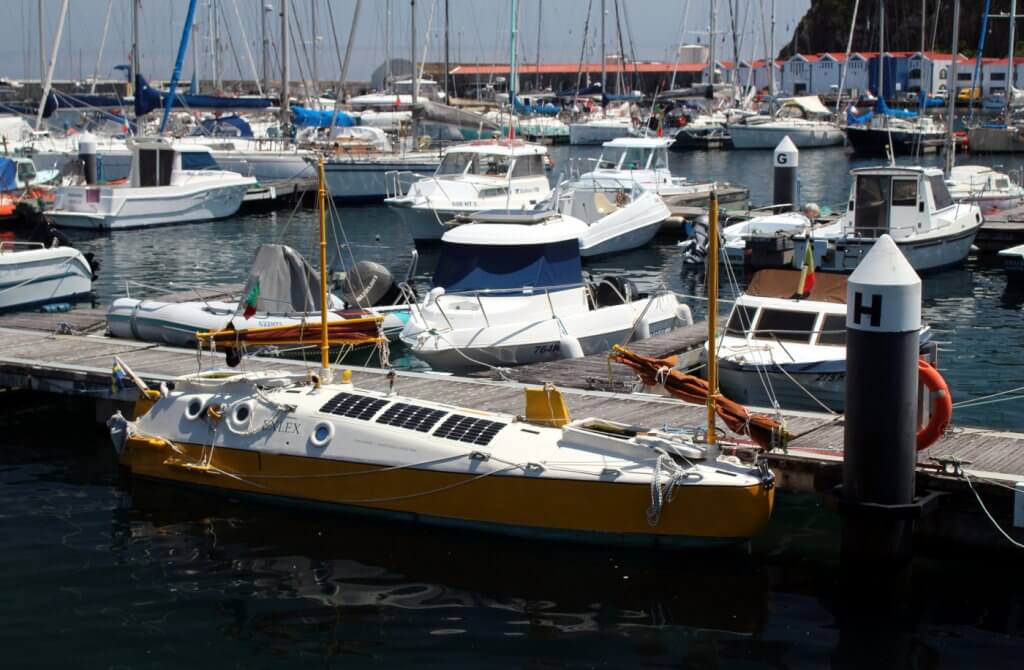
On the colourful quay walls you can find thousands of painted pictures that tell of the adventurous Atlantic crossings. Of course we also left our picture, at least we tried to! Horta has a beautiful old town and charming cafes that have retained the look and feel of the 50s.
One of the most famous bars there is “Peter’s Sports Bar” although we found it overcrowded and very commercial. A far cry from the descriptions from earlier times.
One of the the best things we saw was the sign right by the harbour master’s office ”GoodWood shipwrights”. This is the kind of person we need to replace the damaged teak deck where the water comes in.
A quick email and phone had Harry (the owner of GoodWood and a German) standing on our boat looking at the problem. Yes, he actually had someone on hand who was experienced with teak decks and could renew the rotten teak under the genoa tracks. So the next week the old teak was removed by Jan, a very nice Swede, and new teak strips were fitted.
It didn’t all go according to plan though. The night after the new planks and been fitted (but not sealed) it poured with rain, and the rain poured into the boat through the 78 boltholes. We spent a frantic 2 hours blocking the holes trying plasticine, Blutack and eventually “Leak Hero” (a paste for temporarily patching holes in boats). “Leak Hero” was our hero in the end.
The next day both Harry and Jan returned to see what had gone wrong. Jan had used plenty of Sikaflex 291i sealant but the sealant hadn’t stuck to the deck underneath. A phone call to Najad gave us the answer – they (Najad) had used a Urethane sealant originally and this was incompatible with Sikaflex 291i. Now anyone with a boat will know that Sikaflex sticks to EVERYTHING including things you don’t want it stuck too. But it wouldn’t stick to the Urethane sealant Najad used.
Harry and Jan found a compatible sealant and told us they would have the job finished in a week.
We used the week to take the ferry to the neighbouring island of Pico to camp there again. Two wonderful sites with great views of Pico volcano and great barbeque areas and natural swimming pools.
We carried everything – tent, sleeping bags, cooker, food, plates, utensils, clothes, etc – in two big backpacks and a “granny” shopping trolley. It was heavy and hard work, but enjoyable just the same.
Pico, with its 13,900 inhabitants, is the second largest island of the Azores and is characterised by a chain of volcanic cones. There are several wine-growing areas here. At 2351m, Pico is the highest mountain in Portugal. We did not manage to climb it as the weather conditions must be extremely good. Pico is or was also the island of the whalers until 1984. Today you can find whale watching tours on offer everywhere. They advertised sightings of Sperm whales but we were not sure if they really did see them – plenty of dolphins and the more common Pilot whales.
On our crossing from Faial to Sao Miguel we saw several small groups of Pilot whales and also migrating dolphins. At least whales, although not Fin whales or Sperm whales, which are rather rare.
In Lajes do Pico we met a nice Dutch couple Gus and Anneke with their boat, “Gusanne”, in the marina and spent a very nice evening together in a great restaurant. We invited them to Horta to celebrate John’s birthday in a special restaurant.
The restaurant, “Genuíno”, on the waterfront is run by a 70-year-old Portuguese man who has sailed twice around the world in his Bavaria 36 and has himself managed a broken mast and sailed 3,000 nautical miles with it. An incredible man! The interior of the restaurant is a testimony to his travel memories (pictures, flags and all sorts of things from the various Pacific islands). We had a great evening and were the last guests…
The island of Faial is dominated by a huge volcanic crater. Of course we had to hike the 8km long circular walk around the Caldeira, partly in thick fog. Simply beautiful – long strips of wild flowering hydrangeas everywhere and the interior of the cone 400m below shimmers in all shades of green from over a thousand different plants. Eerily impressive!
Another highlight is the old Capelinhos lighthouse, which was partially destroyed by a volcanic eruption 50 years ago. The eruption in 1957/58 created new offshore land which resembles a lunar landscape and makes the lighthouse look a bit lost. This contrast between the green volcanic cones and this lunar landscape with its various brown tones is almost surreal.
